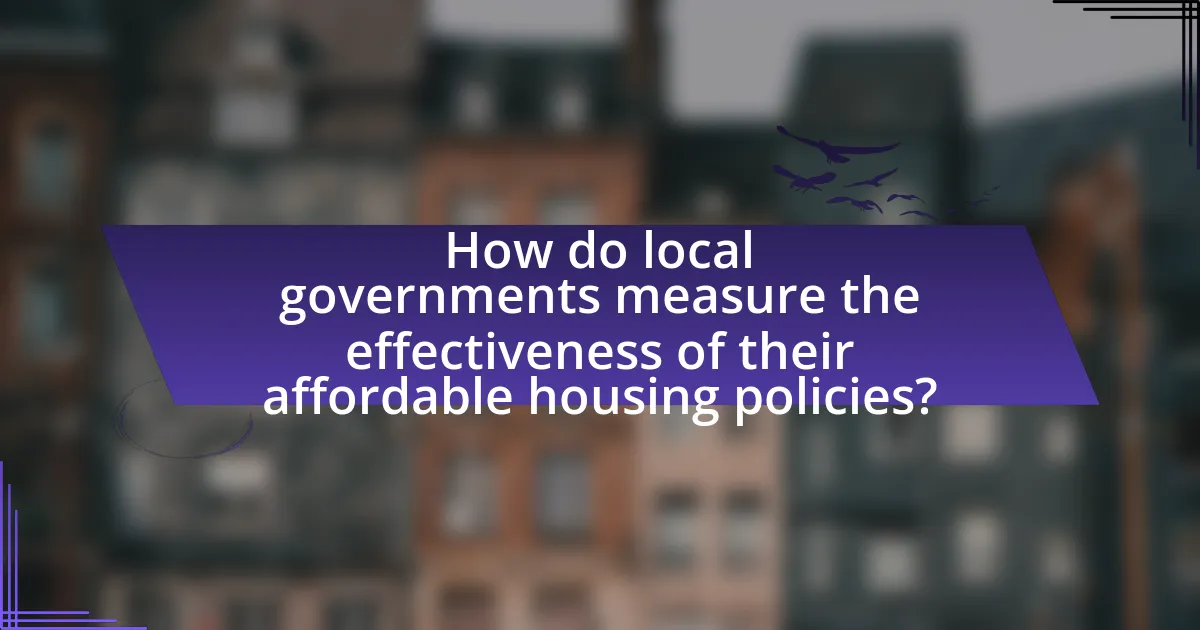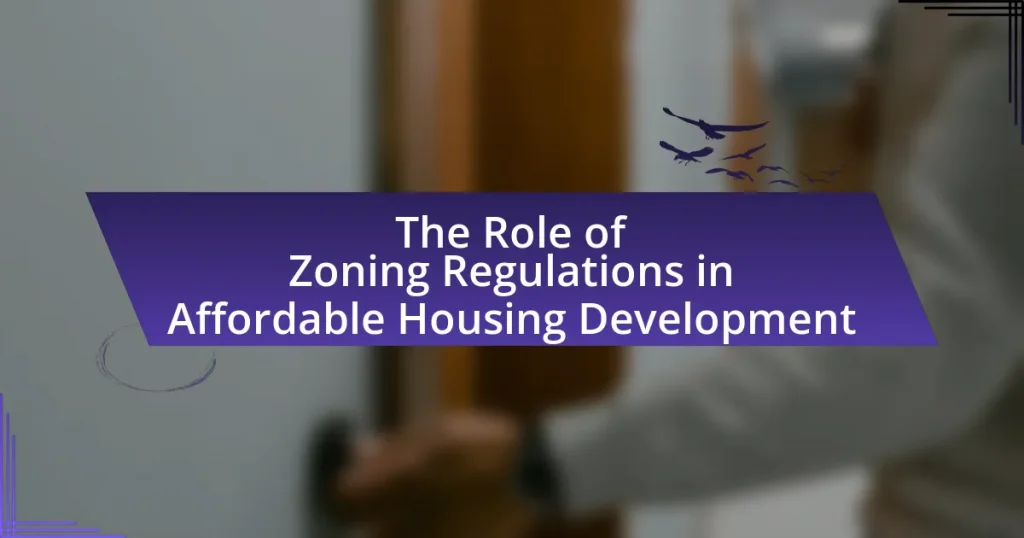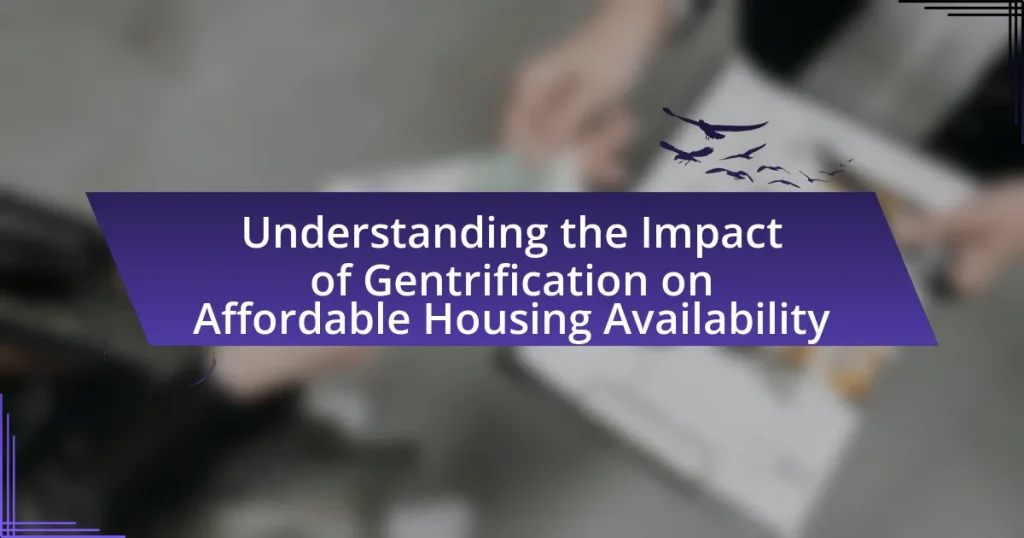Local governments are pivotal in shaping affordable housing policy through their authority over zoning laws, funding allocations, and regulatory frameworks. They implement strategies such as inclusionary zoning, housing trust funds, and density bonuses to increase the availability of affordable housing units. Collaboration with non-profit organizations and private developers enhances these initiatives, while challenges like limited financial resources and community opposition complicate efforts. The effectiveness of local policies is measured through metrics such as housing affordability and occupancy rates, with community feedback playing a crucial role in refining strategies. This article examines the various ways local governments influence affordable housing, the specific policies they adopt, and the best practices that can enhance housing availability and stability.

What is the Role of Local Governments in Shaping Affordable Housing Policy?
Local governments play a crucial role in shaping affordable housing policy by establishing zoning laws, providing funding, and implementing regulations that promote housing development. They have the authority to create and modify land use policies, which directly influence the availability and affordability of housing in their jurisdictions. For instance, local governments can incentivize developers to include affordable units in new projects through inclusionary zoning policies, which have been successfully implemented in cities like San Francisco and New York. Additionally, local governments often allocate funds for affordable housing initiatives, such as grants or low-interest loans, to support construction and rehabilitation efforts. According to the National Low Income Housing Coalition, local policies significantly impact housing affordability, as they determine the types of housing that can be built and the resources available for development.
How do local governments influence affordable housing initiatives?
Local governments influence affordable housing initiatives primarily through zoning regulations, funding allocations, and policy development. By establishing zoning laws, local governments determine where affordable housing can be built, which directly impacts the availability of such housing. For instance, cities that implement inclusionary zoning require developers to include a percentage of affordable units in new projects, thereby increasing the stock of affordable housing. Additionally, local governments often allocate funds for affordable housing projects through budgets and grants, which can significantly enhance the resources available for development. According to the National Low Income Housing Coalition, local governments play a crucial role in shaping housing policy, as they control land use and can incentivize or disincentivize affordable housing through tax credits and subsidies.
What specific policies do local governments implement to promote affordable housing?
Local governments implement various specific policies to promote affordable housing, including inclusionary zoning, housing trust funds, and density bonuses. Inclusionary zoning requires developers to include a percentage of affordable units in new housing projects, which directly increases the availability of affordable housing. Housing trust funds allocate public funds specifically for the development and preservation of affordable housing, ensuring financial resources are available for these initiatives. Density bonuses allow developers to build more units than normally permitted in exchange for including affordable housing, incentivizing the creation of lower-cost units. These policies have been shown to effectively increase the stock of affordable housing in communities across the United States.
How do local governments collaborate with other entities to enhance affordable housing?
Local governments collaborate with non-profit organizations, private developers, and community groups to enhance affordable housing. This collaboration often involves public-private partnerships where local governments provide funding, land, or regulatory support to incentivize the development of affordable housing projects. For example, the U.S. Department of Housing and Urban Development reported that local governments frequently utilize tax credits and zoning adjustments to facilitate these partnerships, resulting in increased affordable housing units. Additionally, local governments may engage in community outreach to identify housing needs and leverage resources from various stakeholders, ensuring that the housing solutions are tailored to the specific demographics and economic conditions of the area.
Why is local government involvement crucial in affordable housing policy?
Local government involvement is crucial in affordable housing policy because it directly influences zoning laws, land use regulations, and funding allocations that shape housing availability. Local governments have the authority to implement policies tailored to their community’s specific needs, ensuring that affordable housing initiatives align with local demographics and economic conditions. For instance, according to the National Low Income Housing Coalition, local governments can leverage federal and state funding to create housing programs that address the unique challenges faced by their residents, such as high housing costs or low income levels. This localized approach enables more effective responses to housing shortages and fosters community engagement in the development process.
What challenges do local governments face in addressing affordable housing?
Local governments face significant challenges in addressing affordable housing, primarily due to limited financial resources and regulatory constraints. Many local governments operate under tight budgets, which restrict their ability to fund affordable housing projects or provide subsidies. Additionally, zoning laws and land use regulations often hinder the development of new affordable housing units, as they can impose restrictions that make it difficult to build or convert properties for low-income residents. According to a report by the National Low Income Housing Coalition, there is a shortage of 7 million affordable rental homes for extremely low-income renters, highlighting the scale of the issue. Furthermore, community opposition, often referred to as NIMBYism (Not In My Backyard), can complicate efforts to introduce new affordable housing developments, as residents may resist changes that they perceive as detrimental to their neighborhoods.
How does local government action impact community development and housing stability?
Local government action significantly impacts community development and housing stability by implementing policies that promote affordable housing, zoning regulations, and infrastructure improvements. These actions directly influence the availability of housing options and the overall quality of life in communities. For instance, local governments can create inclusionary zoning laws that require developers to allocate a percentage of new housing units as affordable, thereby increasing access for low-income residents. Additionally, local governments often allocate funding for community development projects, which can enhance public spaces and services, further stabilizing neighborhoods. Research from the Urban Institute indicates that effective local government policies can lead to a 20% increase in affordable housing availability, demonstrating the critical role of local governance in shaping housing stability and community development.

What are the key strategies employed by local governments in affordable housing policy?
Local governments employ several key strategies in affordable housing policy, including zoning reforms, financial incentives, and partnerships with non-profit organizations. Zoning reforms allow for increased density and mixed-use developments, which can lead to more affordable housing units being built. Financial incentives, such as tax credits and subsidies, encourage developers to create affordable housing options. Additionally, partnerships with non-profit organizations help leverage resources and expertise to address housing needs effectively. These strategies are supported by data indicating that areas with flexible zoning and financial support see a higher rate of affordable housing development, demonstrating their effectiveness in addressing housing shortages.
How do zoning laws affect affordable housing availability?
Zoning laws significantly restrict affordable housing availability by regulating land use, density, and building types. These regulations often favor single-family homes and limit multi-family developments, which are crucial for creating affordable housing options. For instance, a study by the National Low Income Housing Coalition found that restrictive zoning contributes to a shortage of affordable units, exacerbating housing crises in urban areas. Additionally, areas with stringent zoning laws often experience higher housing costs, as the limited supply fails to meet demand, further diminishing affordable housing opportunities.
What changes can local governments make to zoning laws to support affordable housing?
Local governments can amend zoning laws to support affordable housing by increasing density allowances, permitting mixed-use developments, and reducing minimum lot sizes. Increasing density allows for more housing units in a given area, which can lower costs through economies of scale. For instance, cities like Minneapolis have eliminated single-family zoning, enabling the construction of duplexes and triplexes, which has been shown to increase housing availability. Permitting mixed-use developments encourages the integration of residential and commercial spaces, fostering vibrant communities and reducing transportation costs for residents. Additionally, reducing minimum lot sizes can facilitate the construction of smaller, more affordable homes, as seen in various urban areas that have adopted such measures to combat housing shortages.
How do inclusionary zoning policies work in practice?
Inclusionary zoning policies work by requiring developers to include a certain percentage of affordable housing units in new residential projects. This practice aims to create mixed-income communities and increase the availability of affordable housing options. For example, in cities like San Francisco, developers may be mandated to allocate 12-20% of units in a new development as affordable, depending on the project’s size and location. These policies often provide incentives, such as density bonuses or expedited permitting, to encourage compliance. Studies have shown that inclusionary zoning can lead to a significant increase in affordable housing stock; for instance, a report from the Urban Institute found that such policies contributed to the creation of over 10,000 affordable units in various U.S. cities between 2000 and 2015.
What funding mechanisms do local governments use for affordable housing projects?
Local governments utilize various funding mechanisms for affordable housing projects, including federal grants, tax increment financing, and public-private partnerships. Federal grants, such as those from the U.S. Department of Housing and Urban Development, provide essential funding for local initiatives aimed at increasing affordable housing stock. Tax increment financing allows municipalities to capture future tax revenues generated by new developments to fund infrastructure improvements that support affordable housing. Public-private partnerships leverage private investment alongside public funding to create and manage affordable housing projects effectively. These mechanisms are critical in addressing the housing needs of low- and moderate-income residents, as evidenced by the significant impact of federal funding on local housing initiatives.
How do grants and subsidies play a role in local affordable housing initiatives?
Grants and subsidies are crucial in local affordable housing initiatives as they provide essential funding to support the development and maintenance of affordable housing projects. These financial resources enable local governments and organizations to reduce construction costs, making it feasible to offer housing at lower prices for low- and moderate-income families. For instance, the U.S. Department of Housing and Urban Development (HUD) allocates billions in grants annually to local governments, which can be used to subsidize housing projects, thereby increasing the availability of affordable units. This funding mechanism directly addresses the housing affordability crisis by incentivizing developers to create and preserve affordable housing options, ultimately contributing to community stability and economic diversity.
What are the implications of public-private partnerships in affordable housing funding?
Public-private partnerships (PPPs) in affordable housing funding enhance resource allocation and project efficiency. These collaborations leverage public sector oversight and private sector innovation, resulting in increased investment in affordable housing projects. For instance, a study by the Urban Institute found that PPPs can reduce project costs by up to 20% through shared risks and resources. Additionally, these partnerships often lead to faster project completion times, as private entities can mobilize capital and expertise more rapidly than public agencies alone. Overall, the implications of PPPs in affordable housing funding include improved financial viability, accelerated development timelines, and enhanced service delivery, ultimately contributing to the expansion of affordable housing options.

How do local governments measure the effectiveness of their affordable housing policies?
Local governments measure the effectiveness of their affordable housing policies primarily through metrics such as housing affordability, occupancy rates, and the number of affordable units created or preserved. These metrics provide quantifiable data that reflects the impact of policies on the housing market and community well-being. For instance, a study by the Urban Institute found that cities implementing inclusionary zoning policies saw a 15% increase in affordable housing stock over five years, demonstrating a direct correlation between policy implementation and housing availability. Additionally, local governments often conduct surveys and gather feedback from residents to assess satisfaction and identify areas for improvement, further validating the effectiveness of their strategies.
What metrics are used to evaluate affordable housing success?
Metrics used to evaluate affordable housing success include affordability, occupancy rates, and resident satisfaction. Affordability is typically measured by the percentage of income that households spend on housing costs, with a benchmark of 30% often used to define affordability. Occupancy rates indicate the percentage of available units that are occupied, reflecting demand and effectiveness of housing policies. Resident satisfaction surveys assess the quality of living conditions and community engagement, providing qualitative data on the success of affordable housing initiatives. These metrics collectively help local governments gauge the effectiveness of their affordable housing policies and make necessary adjustments.
How do local governments gather data on housing needs and outcomes?
Local governments gather data on housing needs and outcomes through various methods, including surveys, public records analysis, and collaboration with community organizations. Surveys are often conducted to assess resident demographics, income levels, and housing conditions, providing quantitative data on housing demand. Public records, such as building permits and property tax assessments, offer insights into housing supply and market trends. Additionally, partnerships with local nonprofits and housing advocacy groups facilitate the collection of qualitative data, reflecting community perspectives on housing challenges. These combined approaches enable local governments to make informed decisions regarding affordable housing policies and initiatives.
What role does community feedback play in assessing policy effectiveness?
Community feedback is essential in assessing policy effectiveness as it provides direct insights into the experiences and needs of the affected population. Local governments can utilize this feedback to identify gaps in policy implementation and areas for improvement, ensuring that policies align with community expectations and realities. For instance, studies have shown that policies informed by community input tend to have higher satisfaction rates and better outcomes, as they reflect the actual conditions and preferences of residents. This participatory approach not only enhances transparency but also fosters trust between local governments and the community, ultimately leading to more effective and responsive housing policies.
What best practices can local governments adopt to enhance affordable housing policies?
Local governments can enhance affordable housing policies by implementing inclusionary zoning, which requires developers to include a percentage of affordable units in new residential projects. This practice has been adopted in cities like San Francisco, where it has resulted in the creation of thousands of affordable housing units, addressing the housing crisis effectively. Additionally, local governments can streamline the permitting process for affordable housing developments, reducing costs and time for builders, as seen in Minneapolis, which has led to an increase in housing supply. Furthermore, establishing public-private partnerships can leverage resources and expertise, exemplified by the collaboration between the City of Los Angeles and private developers to create mixed-income housing projects. These best practices collectively contribute to a more sustainable and accessible housing market.
How can local governments engage with residents to improve housing strategies?
Local governments can engage with residents to improve housing strategies by implementing participatory planning processes that include public forums, surveys, and workshops. These methods allow residents to voice their needs and preferences, ensuring that housing policies reflect community priorities. For instance, a study by the Urban Institute found that cities that actively involve residents in housing policy discussions see higher satisfaction rates and better alignment of housing initiatives with community needs. Engaging residents not only fosters trust but also enhances the effectiveness of housing strategies by incorporating diverse perspectives and local knowledge.
What innovative approaches have proven successful in other regions?
Innovative approaches that have proven successful in other regions include inclusionary zoning, community land trusts, and public-private partnerships. Inclusionary zoning mandates that a percentage of new housing developments be affordable for low- to moderate-income residents, effectively increasing the supply of affordable housing. For example, San Francisco’s inclusionary housing program has resulted in thousands of affordable units being created since its inception. Community land trusts, such as those in Burlington, Vermont, allow communities to own land collectively, ensuring long-term affordability and preventing speculation. Public-private partnerships, exemplified by the collaboration between the city of New York and private developers, have led to the construction of mixed-income housing projects that integrate affordable units within market-rate developments. These approaches demonstrate effective strategies for local governments to enhance affordable housing availability.



